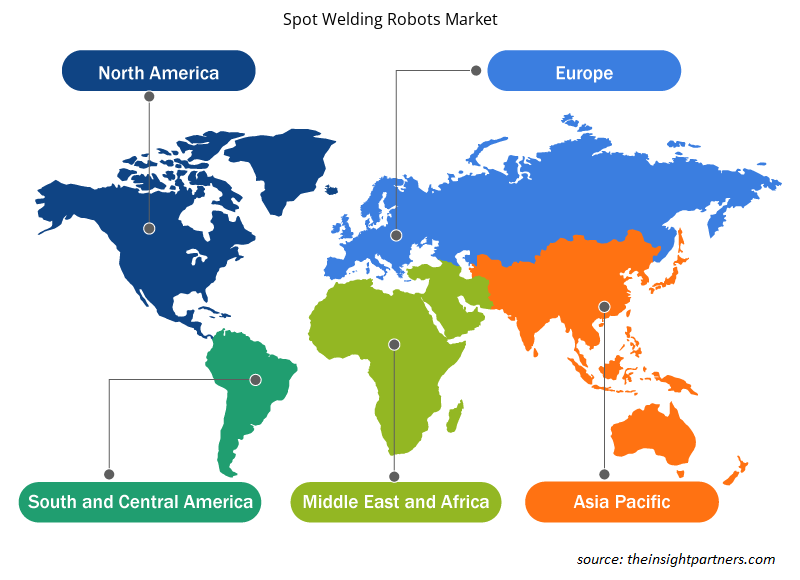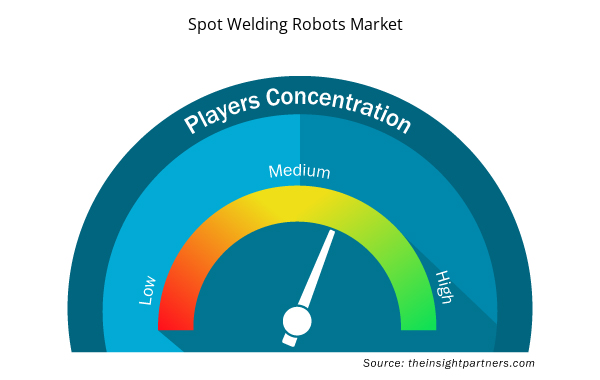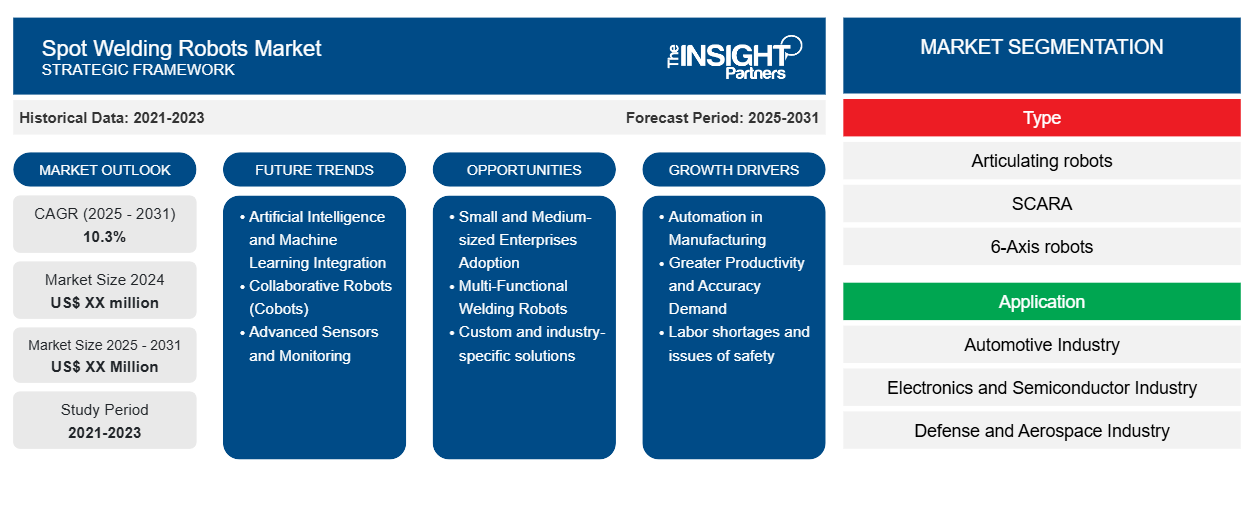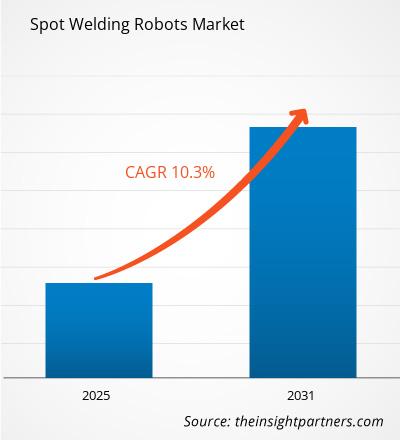The Spot Welding Robots Market is expected to register a CAGR of 10.3% from 2023 to 2031, with a market size expanding from US$ XX million in 2023 to US$ XX Million by 2031.
The Spot Welding Robots Market Report is segmented by Type into the following subsegments: Articulating Robots, SCARA, 6-Axis Robots, Cartesian, and Others. It is also segmented by Application, including Automotive Industry, Electronics and Semiconductor Industry, Defense and Aerospace Industry, and Others. The global analysis is broken down at the regional level and by major countries. The market evaluation is presented in US$ for the above segmental analysis, with projections through 2031.
Purpose of the Report
The report Spot Welding Robots Market by The Insight Partners aims to describe the present landscape and future growth, top driving factors, challenges, and opportunities. This will provide insights to various business stakeholders, such as:
- Technology Providers/Manufacturers: To understand the evolving market dynamics and know the potential growth opportunities, enabling them to make informed strategic decisions.
- Investors: To conduct a comprehensive trend analysis regarding the market growth rate, market financial projections, and opportunities that exist across the value chain.
- Regulatory bodies: To regulate policies and police activities in the market with the aim of minimizing abuse, preserving investor trust and confidence, and upholding the integrity and stability of the market.
Spot Welding Robots Market Segmentation
Type
- Articulating robots
- SCARA
- 6-Axis robots
- Cartesian
- Others
Application
- Automotive Industry
- Electronics and Semiconductor Industry
- Defense and Aerospace Industry
- Others
Customize This Report To Suit Your Requirement
You will get customization on any report - free of charge - including parts of this report, or country-level analysis, Excel Data pack, as well as avail great offers and discounts for start-ups & universities
- Get Top Key Market Trends of this report.This FREE sample will include data analysis, ranging from market trends to estimates and forecasts.
Spot Welding Robots Market Growth Drivers
- Automation in Manufacturing: The Spot Welding Robots market is driven by automation in industries such as automobile, electronics, and consumer goods manufacturing because spot welding robots provide consistent, high-quality welds-critical in high-volume manufacturing environments.
- Greater Productivity and Accuracy Demand: Competition in manufacturing is making companies look for automated spot welding robots.
- Labor shortages and issues of safety: The use of spot welding robots in manufacturing industries is helpful in overcoming labor shortages, as well as growing issues of workplace safety. As robots can take over hazardous tasks, the harm done to the worker would lessen, and an important issue like labor gaps would also be addressed through reliable and more effective production.
Spot Welding Robots Market Future Trends
- Artificial Intelligence and Machine Learning Integration: Integration of AI with machine learning into spot welding robots has improved them to adapt quickly to changed welding conditions leading to excellent weld quality as well as optimizing the welding process. Moreover, AI enabled robots in direct interaction with humans may learn from repeated failures leading to increased efficiency.
- Collaborative Robots (Cobots): Cobots, or collaborative robots, are increasingly appearing in the spot welding sector. They can work together with human operators without the need to use safety cages and guardrails on installations, making them suitable for small to medium enterprises.
- Advanced Sensors and Monitoring: New sensors and real-time monitoring techniques that are permitting the spot welding robots to automatically detect inconsistency in the weld quality and change parameters accordingly. Thus, the welds are high in quality, and there is less scrutiny by humans.
Spot Welding Robots Market Opportunities
- Small and Medium-sized Enterprises Adoption: Although large manufacturers have widely adopted spot welding robots, SMEs especially in the emerging markets, offer large growth opportunities. Affordability, flexibility, and ease of deployment of robotic systems may open new markets.
- Multi-Functional Welding Robots: Development Opportunity A spot welding robot may be designed to perform other types of welding besides spot welding.
- Custom and industry-specific solutions: Companies can build customized spot welding robots for particular industries, namely, automotive, aerospace, and electronics, in which the requirements of weld strength, precision, and speed vary.
Spot Welding Robots Market Regional Insights
The regional trends and factors influencing the Spot Welding Robots Market throughout the forecast period have been thoroughly explained by the analysts at Insight Partners. This section also discusses Spot Welding Robots Market segments and geography across North America, Europe, Asia Pacific, Middle East and Africa, and South and Central America.

- Get the Regional Specific Data for Spot Welding Robots Market
Spot Welding Robots Market Report Scope
| Report Attribute | Details |
|---|---|
| Market size in 2023 | US$ XX million |
| Market Size by 2031 | US$ XX Million |
| Global CAGR (2023 - 2031) | 10.3% |
| Historical Data | 2021-2022 |
| Forecast period | 2024-2031 |
| Segments Covered | By Type
|
| Regions and Countries Covered | North America
|
| Market leaders and key company profiles |
|
Spot Welding Robots Market Players Density: Understanding Its Impact on Business Dynamics
The Spot Welding Robots Market market is growing rapidly, driven by increasing end-user demand due to factors such as evolving consumer preferences, technological advancements, and greater awareness of the product's benefits. As demand rises, businesses are expanding their offerings, innovating to meet consumer needs, and capitalizing on emerging trends, which further fuels market growth.
Market players density refers to the distribution of firms or companies operating within a particular market or industry. It indicates how many competitors (market players) are present in a given market space relative to its size or total market value.
Major Companies operating in the Spot Welding Robots Market are:
- ABB Ltd
- Comau Spa
- DAIHEN Corp
- FANUC Corporation
- Fiat Chrysler Automobiles N.V.
Disclaimer: The companies listed above are not ranked in any particular order.

- Get the Spot Welding Robots Market top key players overview
Key Selling Points
- Comprehensive Coverage: The report comprehensively covers the analysis of products, services, types, and end users of the Spot Welding Robots Market, providing a holistic landscape.
- Expert Analysis: The report is compiled based on the in-depth understanding of industry experts and analysts.
- Up-to-date Information: The report assures business relevance due to its coverage of recent information and data trends.
- Customization Options: This report can be customized to cater to specific client requirements and suit the business strategies aptly.
The research report on the Spot Welding Robots Market can, therefore, help spearhead the trail of decoding and understanding the industry scenario and growth prospects. Although there can be a few valid concerns, the overall benefits of this report tend to outweigh the disadvantages.
- Análisis histórico (2 años), año base, pronóstico (7 años) con CAGR
- Análisis PEST y FODA
- Tamaño del mercado Valor/volumen: global, regional, nacional
- Industria y panorama competitivo
- Conjunto de datos de Excel



Report Coverage
Revenue forecast, Company Analysis, Industry landscape, Growth factors, and Trends

Segment Covered
This text is related
to segments covered.

Regional Scope
North America, Europe, Asia Pacific, Middle East & Africa, South & Central America

Country Scope
This text is related
to country scope.
Preguntas frecuentes
Some of the customization options available based on request are additional 3-5 company profiles and country-specific analysis of 3-5 countries of your choice. Customizations are to be requested/discussed before making final order confirmation, as our team would review the same and check the feasibility.
Future trends encompass the integration of AI for improved welding quality control, growth in collaborative robots, known as cobots, for flexible manufacturing environments, and further developments in robotic welding systems to handle more complex welding tasks.
Key players include: ABB Ltd, Comau Spa, DAIHEN Corp, FANUC Corporation, Fiat Chrysler Automobiles N.V., Kawasaki Heavy Industries Ltd, KUKA AG, Midea Group, Nachi Robotics Systems, Inc., Yaskawa Electric Corporation,
The market is expected to register a CAGR of 10.3% during 2023-2031.
The driving factors for the Spot Welding Robots Market are the increasing adoption of automation in manufacturing industries, especially in automotive production, a rising need to improve welding process precision, and advancement in robotic technologies.
The report can be delivered in PDF/PPT format; we can also share excel dataset based on the request.
Trends and growth analysis reports related to Electronics and Semiconductor : READ MORE..
1.ABB Ltd
2.Comau Spa
3.DAIHEN Corp
4.FANUC Corporation
5.Fiat Chrysler Automobiles N.V.
6.KUKA AG
7.Kawasaki Heavy Industries, Ltd.
8.Midea Group
9.Nachi Robotics Systems, Inc.
10.Yaskawa Electric Corporation
The Insight Partners performs research in 4 major stages: Data Collection & Secondary Research, Primary Research, Data Analysis and Data Triangulation & Final Review.
- Data Collection and Secondary Research:
As a market research and consulting firm operating from a decade, we have published and advised several client across the globe. First step for any study will start with an assessment of currently available data and insights from existing reports. Further, historical and current market information is collected from Investor Presentations, Annual Reports, SEC Filings, etc., and other information related to company’s performance and market positioning are gathered from Paid Databases (Factiva, Hoovers, and Reuters) and various other publications available in public domain.
Several associations trade associates, technical forums, institutes, societies and organization are accessed to gain technical as well as market related insights through their publications such as research papers, blogs and press releases related to the studies are referred to get cues about the market. Further, white papers, journals, magazines, and other news articles published in last 3 years are scrutinized and analyzed to understand the current market trends.
- Primary Research:
The primarily interview analysis comprise of data obtained from industry participants interview and answers to survey questions gathered by in-house primary team.
For primary research, interviews are conducted with industry experts/CEOs/Marketing Managers/VPs/Subject Matter Experts from both demand and supply side to get a 360-degree view of the market. The primary team conducts several interviews based on the complexity of the markets to understand the various market trends and dynamics which makes research more credible and precise.
A typical research interview fulfils the following functions:
- Provides first-hand information on the market size, market trends, growth trends, competitive landscape, and outlook
- Validates and strengthens in-house secondary research findings
- Develops the analysis team’s expertise and market understanding
Primary research involves email interactions and telephone interviews for each market, category, segment, and sub-segment across geographies. The participants who typically take part in such a process include, but are not limited to:
- Industry participants: VPs, business development managers, market intelligence managers and national sales managers
- Outside experts: Valuation experts, research analysts and key opinion leaders specializing in the electronics and semiconductor industry.
Below is the breakup of our primary respondents by company, designation, and region:

Once we receive the confirmation from primary research sources or primary respondents, we finalize the base year market estimation and forecast the data as per the macroeconomic and microeconomic factors assessed during data collection.
- Data Analysis:
Once data is validated through both secondary as well as primary respondents, we finalize the market estimations by hypothesis formulation and factor analysis at regional and country level.
- Macro-Economic Factor Analysis:
We analyse macroeconomic indicators such the gross domestic product (GDP), increase in the demand for goods and services across industries, technological advancement, regional economic growth, governmental policies, the influence of COVID-19, PEST analysis, and other aspects. This analysis aids in setting benchmarks for various nations/regions and approximating market splits. Additionally, the general trend of the aforementioned components aid in determining the market's development possibilities.
- Country Level Data:
Various factors that are especially aligned to the country are taken into account to determine the market size for a certain area and country, including the presence of vendors, such as headquarters and offices, the country's GDP, demand patterns, and industry growth. To comprehend the market dynamics for the nation, a number of growth variables, inhibitors, application areas, and current market trends are researched. The aforementioned elements aid in determining the country's overall market's growth potential.
- Company Profile:
The “Table of Contents” is formulated by listing and analyzing more than 25 - 30 companies operating in the market ecosystem across geographies. However, we profile only 10 companies as a standard practice in our syndicate reports. These 10 companies comprise leading, emerging, and regional players. Nonetheless, our analysis is not restricted to the 10 listed companies, we also analyze other companies present in the market to develop a holistic view and understand the prevailing trends. The “Company Profiles” section in the report covers key facts, business description, products & services, financial information, SWOT analysis, and key developments. The financial information presented is extracted from the annual reports and official documents of the publicly listed companies. Upon collecting the information for the sections of respective companies, we verify them via various primary sources and then compile the data in respective company profiles. The company level information helps us in deriving the base number as well as in forecasting the market size.
- Developing Base Number:
Aggregation of sales statistics (2020-2022) and macro-economic factor, and other secondary and primary research insights are utilized to arrive at base number and related market shares for 2022. The data gaps are identified in this step and relevant market data is analyzed, collected from paid primary interviews or databases. On finalizing the base year market size, forecasts are developed on the basis of macro-economic, industry and market growth factors and company level analysis.
- Data Triangulation and Final Review:
The market findings and base year market size calculations are validated from supply as well as demand side. Demand side validations are based on macro-economic factor analysis and benchmarks for respective regions and countries. In case of supply side validations, revenues of major companies are estimated (in case not available) based on industry benchmark, approximate number of employees, product portfolio, and primary interviews revenues are gathered. Further revenue from target product/service segment is assessed to avoid overshooting of market statistics. In case of heavy deviations between supply and demand side values, all thes steps are repeated to achieve synchronization.
We follow an iterative model, wherein we share our research findings with Subject Matter Experts (SME’s) and Key Opinion Leaders (KOLs) until consensus view of the market is not formulated – this model negates any drastic deviation in the opinions of experts. Only validated and universally acceptable research findings are quoted in our reports.
We have important check points that we use to validate our research findings – which we call – data triangulation, where we validate the information, we generate from secondary sources with primary interviews and then we re-validate with our internal data bases and Subject matter experts. This comprehensive model enables us to deliver high quality, reliable data in shortest possible time.


 Obtenga una muestra gratuita de este informe
Obtenga una muestra gratuita de este informe